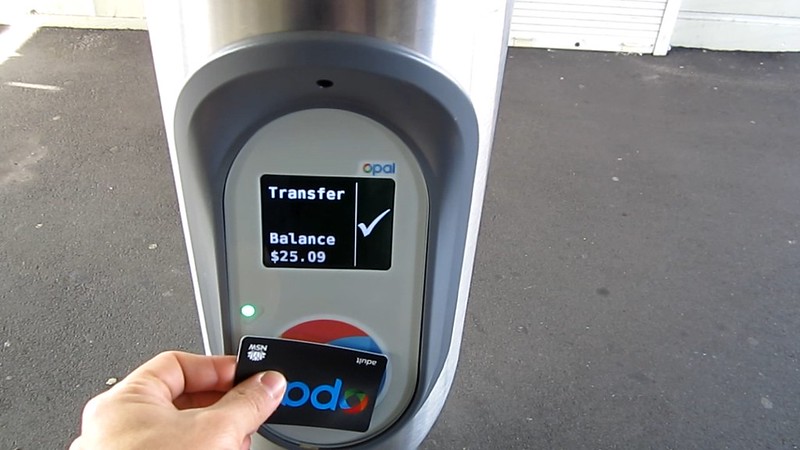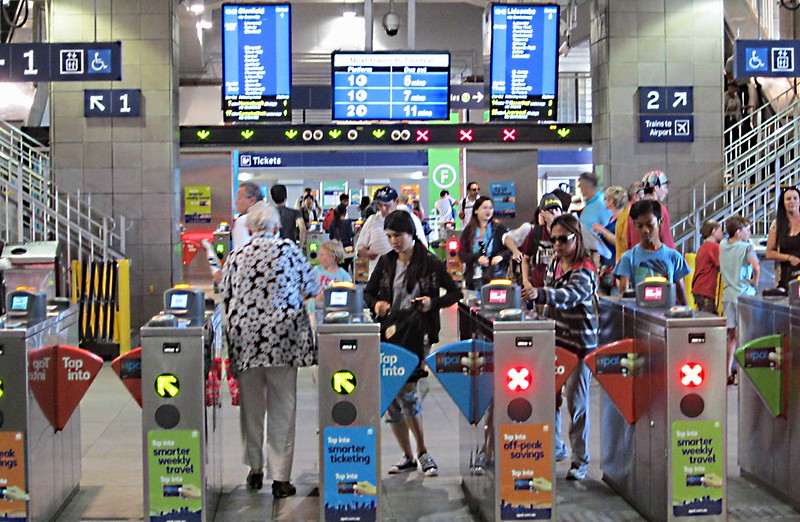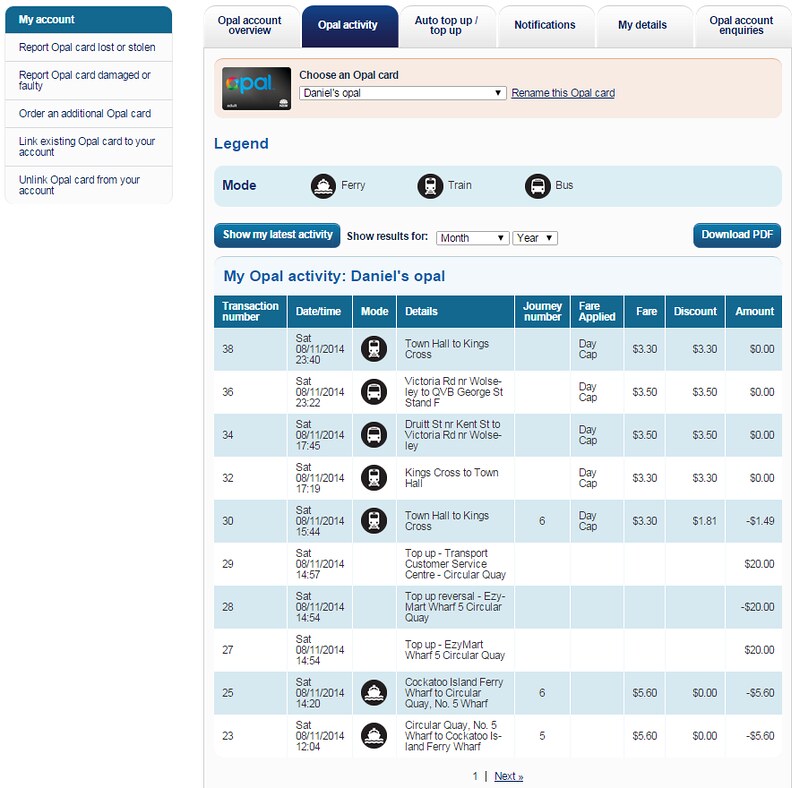(Backdated. Posted 14/11/2014.)
During the Sydney trip I tried out Opal card, and M got one as well to try.
It’s worth remembering that although the system is provided by Cubic, who built London’s Oyster system, its cost is not insubstantial — $1.2 billion over 15 years. It’s not quite as expensive, but is in the ballpark as Myki ($1.5 billion over ten years).
Obtaining and topping up
I ordered mine online; it arrived by post within about a week. They’re only available online, or via retailers. Not stations.
Same with topping up, which is heavily restricted as to the amounts you can use. At retailers it’s $10, $20 etc. Online it’s only $40, $80, $120…! At least online topup is fast — one hour vs Myki’s “up to 24 hours” (though in practice Myki is often faster).
The cards are free, but with a minimum top-up.
It’s unclear if they will make buying and topping-up more widely available in future or not. One local contact believes they plan to push Auto Topup for most users — this of course is impractical for most tourists.
For now the paper (magnetic stripe) ticket machines remain in use, and presumably will be kept for some time, alongside Opal — perhaps indefinitely as a single use ticket option?
In use
This is what really matters: from the first trip on the airport train on the first day, to the last use late on Saturday night, it was easy. Tap on, tap off (and that’s the language they use). The response times on stations, buses and ferries seemed uniformly fast, unlike Myki (which changed its language from “scan” to “touch” when it became obvious the response times wouldn’t be fast enough for “scan”).
The fare gates and buses still take the mag stripe tickets as well. Suburban stations and ferry stops had standalone readers on poles, which are a lot nicer looking than the Myki or Go Card ones. (Unlike in Brisbane, which has readers on the ferries, Sydney’s are on the wharves.)
The balance/status was shown on each tap on a colour screen… but it doesn’t stay up if you hold the card to it, as with Myki.
Fares
The fares are confusing.
Sydney is keeping its segmented fare system, and the base fares are reasonably priced, but the different modes are all charged separately.
Change from bus to bus? Or train to train? Ferry to ferry? All free, as long as the next trip is less than an hour later. (The light rail is not yet on Opal.)
Mix the modes? You get charged again, with no discount. It means the fares can quickly add up — on one day we took all three modes, and it ended up costing about double what similar travel might have costed cost in Melbourne.
No free transfer between modes has big implications for the network, and helps explain why so many Sydney bus routes run all the way into the city, duplicating trains.
Apparently there are hints that fares will be reformed in the future, but nothing is confirmed.
There are caps to stop costs getting too out of hand. This I found somewhat confusing.
It’s 8 journeys then free for the rest of the week, so if you travel a lot at the start of the week, you’ll find the rest of your travel until Sunday is free. I knew about this one, but expected (rightly) that we wouldn’t get to the 8, even with a fair bit of moseying around.
There’s also a $15 per day cap (a bargain $2.50 on Sundays). We hit the $15 cap on Saturday, via multiple train, ferry and bus trips.
The caps replace most of the weekly/monthly/yearly options on the old ticket system. There have been complaints that a lot of people end up paying more overall under the new system.
I didn’t know (or had forgotten) about the $15 cap, and we ended up unnecessarily topping up our cards as I thought we needed to pay a few more fares on our travels.
But we hit the $15 cap on Saturday, and ended up with balances above the top-up levels, meaning we would have never hit zero if we hadn’t topped-up. So we needn’t have bothered. Perhaps… or not? Unlike Myki the minimum balance to tap-on and keep travelling isn’t zero — it’s the minimum possible fare: $2.10 for buses, $3.30 for trains, and $5.60 for ferries. This reflects that the card itself is free, though you could still drive the balance below zero by then making a trip that’s a longer distance.
So if we hadn’t topped-up, even though we hit the daily cap, I don’t know if we’d have been able to keep tapping-on to travel, because we would have been below the minimum balance.
As it is, I have $20.28 left on my card ready for my next trip to Sydney. It seems you can get an unused balance refunded by returning the card — but only paid into an Australian bank account or via a cheque, so impractical for overseas tourists.
Web site
Finally, the web site. It’s good. Obviously it’s relatively new. The Myki web site appears not to have been revamped since its original design probably in about 2007.
The transaction list updated a little slowly for buses, but quickly for trains and ferries (which have fixed readers). It’s a lot more readable because it shows the data by trip, rather than by individual transaction/touch like Myki does.
In conclusion
Over three days (not the most exhaustive test), I found the Opal system reliable and fast (consistently faster than the notoriously inconsistent Myki), but there are very limited top-up options (and it’s unclear if this will be fixed), and fare system leaves a lot to be desired (ditto).
- From back in 2010: Sydney’s new MyMulti fares




14 replies on “Sydney’s Opal card”
As a now regular user of Opal, it has been consistently fast to read. That said we get a *lot* of reader bugs, at least on busses.
One of the terminals near the rear doors on all the busses will randomly start resetting. A little disturbing when you’re approaching your stop.
The bus terminal readers also rrgularly give two responses after tapping on/off… The initial ‘success’ message, followed by a ‘invalid card’ message. This is when holding the opal card on its own to the reader – no wallet or phone to interfere.
I’m not sure how the auto topup works on Myki, but twice now I have boarded a bus, tapped on, and the minimum ticket value put me close to $10. Tapping off at the maximum of $4.50 has pushed it under $10.00, and the reader immediately puts the topup amount on the opal card.
The first time this happened it was 3-4 days before the charge showed up on my credit card, as all my trips were that far behind synchronisation with the site. I was starting to wonder how many unverified topups the system would permit me, as I was getting close to the topup amount.
Thanks for the summary. I guess the bottom line is COST which is to some extent independent of the card system. A daily max of $15 will be about double the Melbourne daily max in 2015 (when zone 2 is sort of abolished). Also the $2.50 on Sundays is a lot better than our current $6. The fact that each mode of transport sort of operates separately is also annoying – again, nothing to do with the card system.
Over Xmas my family will be in Sydney. We will use PT on the Sunday we are there to take advantage of the cheap fares -otherwise, use the car !
While I agree the distance charging appears complicated to someone used to flat or zonal fares it is needed in a system as big as NSW.
The Opal card let’s you travel Newcastle-Sydney-Wollongong and up into the blue mountains. Easy to cover 300+km. You need to charge more for the longer trips to keep it affordable for the shorter fares.
This sounds like a fair report (no pun intended). Speaking as a teacher “what similar travel might have costed in Melbourne” should have been “what similar travel might have *cost* in Melbourne”. It’s a participle.
I’ve found it useful on the whole, but I’m a commuter. Topping up at the local newsagent is fairly easy. The government should fix the multi-modal travel thing and simply measure distance. It’s theoretically possible to credit at the end of each week any overpayments so they can work out retrospectively what you should have paid,. Phone credit works the same way after all.
@Matt, bear in mind that Myki is all zones, but covers a large chunk of regional Victoria – as far out as Geelong, Ballarat, Bendigo, Seymour and Traralgon. (It was originally planned to cover almost all of Victoria, but was scaled back.)
I like the large, clear font on the Opal readers. The Myki readers, with their much smaller font, can be a problem for people with vision disabilities, even more so if they get scratched or if the sun is glaring on them.
Daniel, do you know what the justification is for keeping the segmented fare system? Seems crazily inefficient.
Wouldn’t it be wonderful if our Mykis worked in Sydney and vv! Guess that won’t happen, but in London you don’t need an Oyster as you can now pay with your contactless debit/credit card (see http://www.tfl.gov.uk/fares-and-payments/contactless). Guess it might take a while for Australia to catch up……..
The screens are so clear and easy to read. Remarkable that ours are not. Given the cost of using the train from the airport, I wonder how that fits into the daily and weekly caps, or maybe it doesn’t.
@gxh, CommBank have said they’re working on trialling card payments for Sydney PT. It might help that they’re part of the consortium managing Opal. (See SMH)
@Andrew, the airport surcharge (station access fee) doesn’t count towards daily and weekly caps, though it has a cap of its own – basically you don’t pay it more than twice in any week, which is good for airport workers.
Once you hit a cap, then minimum fares to touch on no longer apply, and you can touch on with a low balance. (I’ve personally only verified that for the 8-journey cap, but I believe others have tested that for the $15 daily cap too.)
The minimum top-up at retailers is $10 for adult cards, $5 for child cards and $2.50 for senior cards.
The biggest, most noticeable difference compared to myki seems to be that Opal readers actually work, and don’t just fail silently on every tram. ;)
It is worth remembering that Sydney first went to tender for their new Smartcard ticketing system in 1998, which means it will be around 20 years from the formation of the project (which occurred a few years before they went to tender) until the system is completed. There were also massive costs from their aborted first attempt at the system (which was won by ERG and then ended in a contractual disaster). So it isn’t true to say that Opal cost less than myki – the overall project cost massively more. Even more important than that was that Sydney had to maintain a large number of duplicate staff at stations for more than a decade due to the absence of an ability to pre-purchase and validate a ticket (eg passengers couldn’t pre-purchase rail tickets in Sydney as there was no where to validate them at stations – unlike Metcard). So that meant you had stations with very large numbers of ticket selling staff (eg. multiple windows required to be open and a lot more vending machines to be installed and maintained). It also meant much longer queues than Melbourne. The additional staff and vending machines in Sydney further added to costs. Add it all up – and Sydney has ended up spending several times what myki cost, and their project took twice as long.
Wrong on almost every point, Adrian.
I’m pretty confident in my facts. :)
http://en.wikipedia.org/wiki/Tcard
http://en.wikipedia.org/wiki/Opal_card
The smartcard project started in Sydney in 1996…Opal isn’t finished yet – so that’s approximately 20 years for the entire project.
Sydney has needed to spend a significant amount of money on staffing, because of the inability for customers to purchase tickets in advance. A passenger who isn’t traveling enough to warrant a periodical ticket had very few options in Sydney prior to Opal. In Melbourne the 10x2hr or 5xDaily Metcards provided even occasional users with the ability to pre-purchase. Plenty of stations in Sydney need to have two or three staff selling tickets for the AM peak, even with a large number of vending machines. By contrast, only a very few number of stations in Melbourne need more than one ticket seller, or more than a small number of vending machines.
Sydney has spent an extraordinary amount of money on ticket selling staff, that could have been better spent on increasing service frequencies. There aren’t any customer benefits for making them line up to purchase a ticket – in fact it actually discourages people who might get a lift in but get the train home (if they have to line up every day to purchase a ticket home).
So I stand by my comment that the Sydney smartcard system took around twice the time as the Melbourne project and cost several times more, driven by the need to start over with a new contractor plus the significant costs that were incurred by maintaining a system that had a much higher number of transactions than it needed to (due to the inability to pre-purchase or bulk purchase and validate). Higher number of transactions meant more staff, more vending machines, more cash collection, etc.
One of the interesting things about Metcard is that while patronage approximately doubled, the number of tickets sold only increased by around 10% over the total life of the system. This was driven by more people moving to 10x2hr, 5xDaily tickets.
It’s all in the past now – but it is just worth pointing out that when looking at smartcards you need to look at not only the contract costs, but the other costs to the industry.